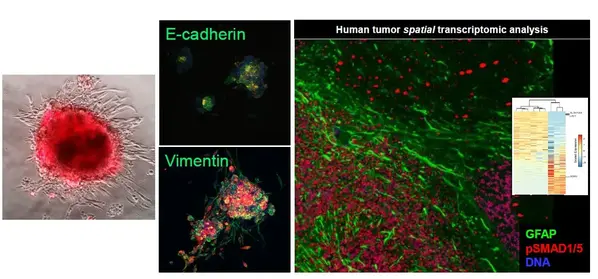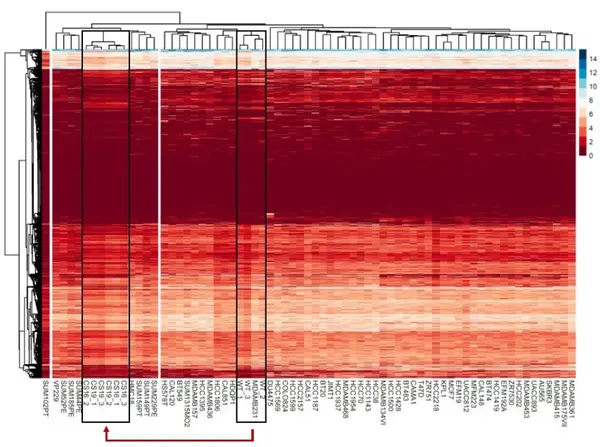Aristidis Moustakas research group
%20gruppbild%20Aris.webp)
TGF-β signaling and cancer cell plasticity
Our research profile falls into the general field of molecular and cell biology. We have developed specialized expertise in signal transduction, gene expression regulation and cell plasticity. We study these biological processes in the context of cancer. Our approaches generate significant opportunities for deep understanding of cancer biology, the generation of new tools for the detection of cancers, and also opens ground for the future design of new treatment modalities.
An important goal in cancer research is to understand the so-called “hallmarks of cancer”. Among the fourteen hallmarks, we focus on those known as “Unlocking phenotypic plasticity” and “Activating invasion and metastasis”, because these hallmarks directly link to cancer metastasis, where targeted treatment remains largely unavailable. Metastasis is also the major cause of death of cancer patients that receive treatment. Thus, research in this area promises to lead to the development of new anti-metastatic protocols, in addition to the generation of molecular tools that can follow the metastatic cells in patients.

Figure: Breast cancer 3D culture expressing Td-tomato (red) with invading cells (left) stained for E-cadherin and vimentin (middle) demonstrates plasticity changes. Right: human tumor stained for glial acidic fibrillary protein (GFAP), phosphorylated SMAD1/5 (pSMAD1/5) and DNA was used for spatial transcriptomic analysis, generating gene profiles (inset).
We have developed strong research activity on the family of growth factors that are known as transforming growth factor beta (TGF-beta), which include proteins like TGF-beta and bone morphogenetic proteins (BMP). TGF-beta or BMP regulate many different biological processes in the human body, e.g. cell division, differentiation and cell death. TGF-betas and BMPs are secreted from cells and bind to receptors on the cell surface. The receptors activate Smad proteins and several protein and lipid kinase pathways inside the cells. The signaling pathways of the TGF-beta family are regulated by different proteins or RNAs (known as non-coding RNAs) that ensure that the molecular signals perform their function properly. We are interested in uncovering these regulatory mechanisms as they frequently malfunction in cancer cells, and thus misdirect the physiological and homeostatic functions of the TGF-beta family to functions that promote the survival and spreading of the tumor tissue inside the body.
Our research spans several tumor types, breast, lung, liver cancer and brain tumors (medulloblastoma and glioblastoma), aiming at uncovering common, general principles that explain the behavior of these tumor types under the action of TGF-beta family members. We map the complex signaling routes and their connections to transcription factors and gene networks that orchestrate the behavior of malignant cells.

Figure: Hierarchical gene expression dendrogram of 68 human breast cancer cell lines highlights that the triple-negative cell model MDAMB231 (middle black rectangle) exhibits differentiation plasticity and shifts (red arrow) to a luminal-like breast cancer phenotypic space (left rectangle).
We use complementary cell models that are cultured in vitro in 2D or in 3D as tumor-organoids, we employ zebrafish and mice as host organisms of tumor growth and metastasis and we specialize on several high-throughput technologies such as transcriptomics (bulk, single cell and spatial), epigenomics (CUT&RUN/TAG and chromatin immunoprecipitation-sequencing) and mass spectrometry-based proteomics. The most central cell biological aspects of our research programs include gene regulation and epigenetic mechanisms, non-coding RNAs, secretion of extracellular vesicles and 3D tumor tissue organization.

Figure: Model of an extracellular vesicle carrying TGF-β and other proteins (left), cryo-electron microscopy images of real human breast cancer vesicles carrying TGF-β (middle) and human breast cancer cells (red) circulating in the vasculature of transgenic zebrafish with green vasculature, as they extravasate to the tail (yellow arrowheads).
In summary, our medically oriented research programs deepen our understanding of hallmarks of cancer and attempt to pioneer discovery in the biochemical function of yet uncharacterized genes at the RNA and protein level.
